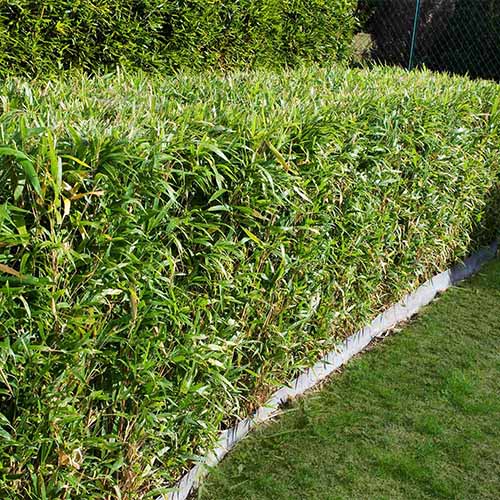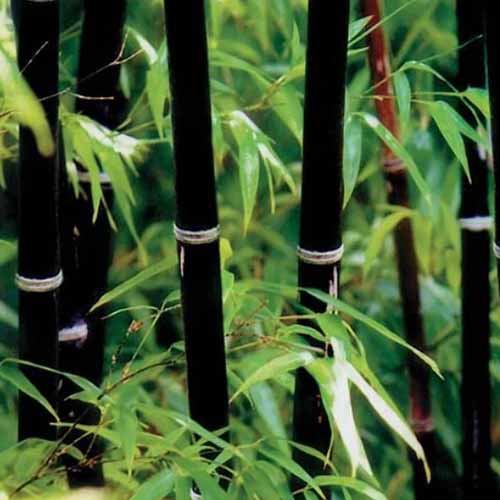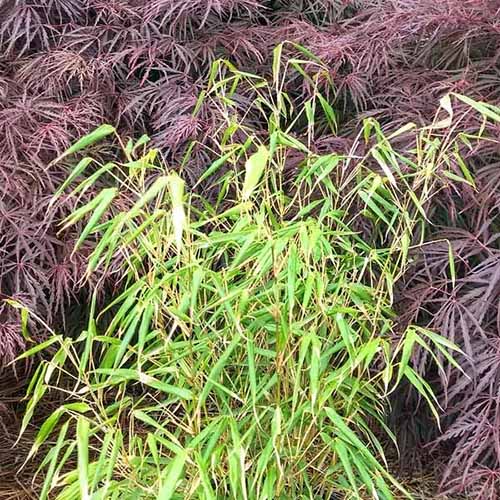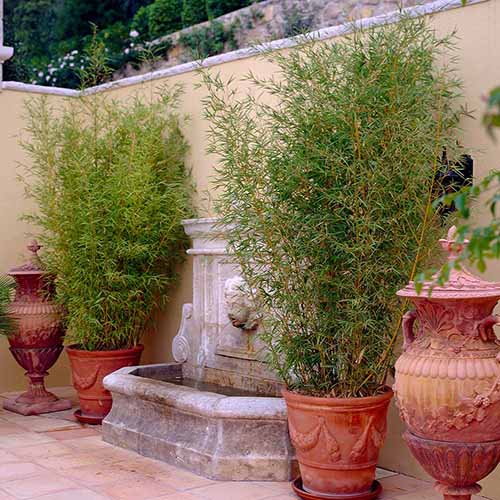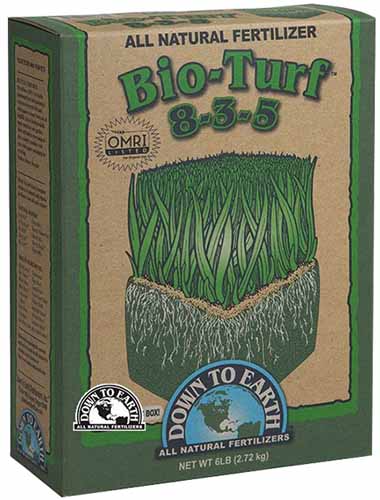Bamboo is appreciated for its tall stands of slender culms with lush, airy foliage, and growing it in containers is an excellent way to enjoy these plants in small spaces – or to keep them from taking over your yard!
Fast growing and versatile, their lush growth is superb for creating leafy accents on decks and patios, or to form evergreen barriers, groves, hedges, and privacy screens.

We link to vendors to help you find relevant products. If you buy from one of our links, we may earn a commission.
With the right type of soil plus adequate light, nutrients, space, and water, container growth produces lush bamboo plants while easily managing their size and spread.
The clumping types are slower to spread than the quickly colonizing running types, but all varieties produce robust root systems, so large containers are needed.
Are you ready to create your own tropical grove of bamboo planters? Then let’s dig into how to grow bamboo in pots and containers.
Here’s a peek at what’s ahead:
What You’ll Learn
Clumping and Running Types
Bamboo grows and spreads from rhizomes, the thick, fleshy roots that branch readily and inhabit the top six to 12 inches of soil.
A subfamily of true grasses (Poaceae), bamboo (Bambusoideae), is categorized into two broad types – clumping or running varieties – which describes their root and growth style.
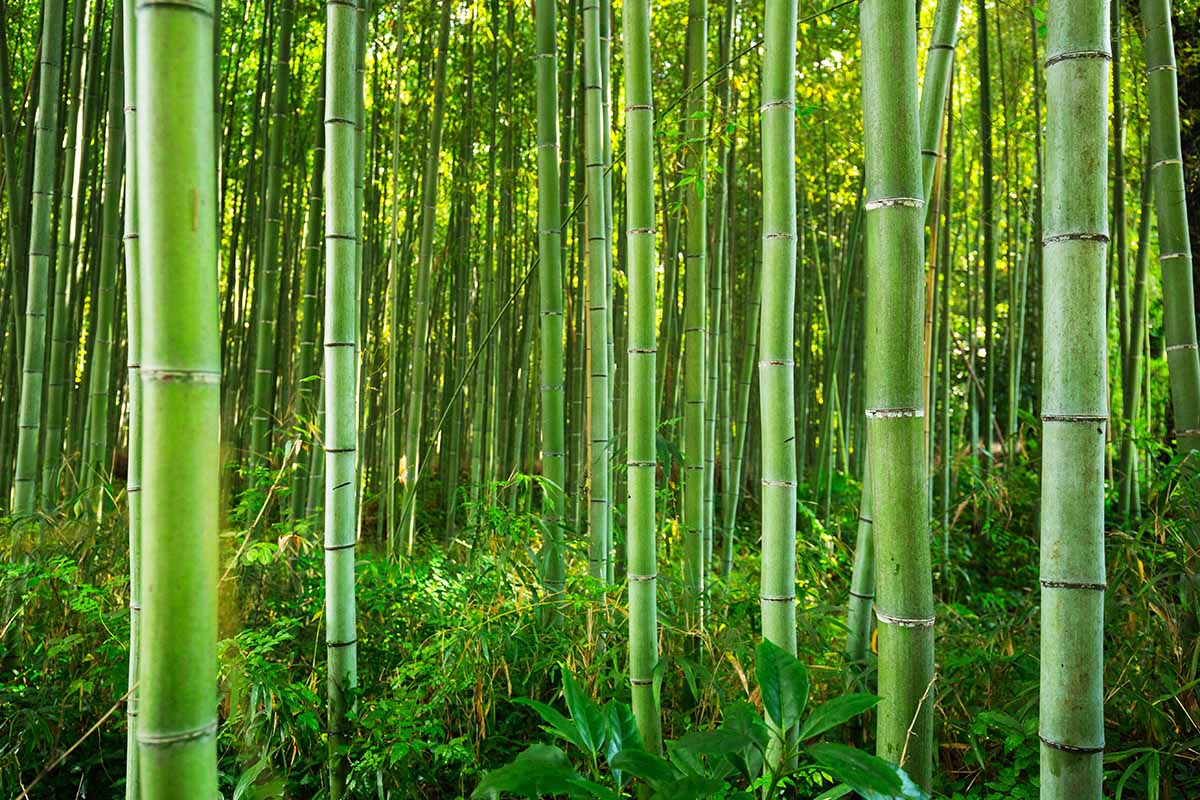
Clumping varieties are usually of tropical origin with roots that expand at a steady, but reasonable pace and they’re more susceptible to damage from cold temperatures.
Running types are temperate plants that are generally more cold-hardy and have exuberant, running root growth that can quickly take over any available space.
This means the running types need to be divided or repotted more frequently than the clumping varieties.
But even the clumping types need regular repotting. Even though their growth is less aggressive than the runners, it’s still vigorous and it doesn’t take long for the plants to become rootbound.
Both types adapt well to growing in containers, giving you a smart way to control their size and spread.
If you’d like to learn more, check out our guide to the differences between clumping and running bamboo.
Container Requirements
Containers for growing bamboo can be made of any material, including concrete, ceramic, resin, terra cotta, and wood.
The main consideration for container growth is space, and lots of it – the bigger the planter, the happier and healthier your bamboo plant will be. And you won’t have to repot or divide as frequently as you would if you planted it in smaller pots.
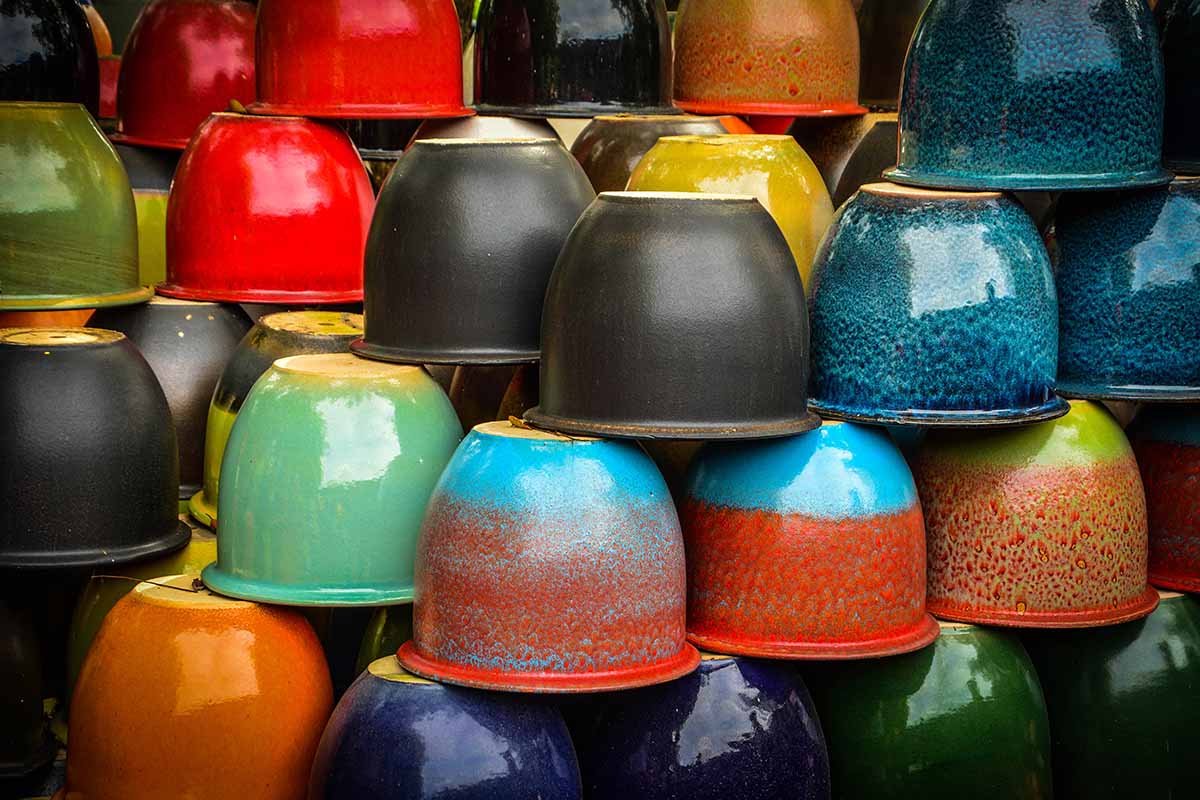
A 10-gallon capacity should be the minimum size for any type, and as mentioned, in the case of bamboo, bigger is better. Especially for running varieties – a 20-gallon pot is more their style.
Large planters also have the advantage of providing better insulation for the roots if freezing winter temperatures are a concern.
And the weight they provide helps to counterbalance the ample foliage of mature plants and prevent them from tipping over.
Also, any container used must have drainage holes to prevent the roots from standing in soggy conditions, which can cause root rot.
A single hole that’s about half an inch to an inch in diameter is okay, but three or four drainage holes would be better. Use a drill to create additional holes if needed.
Lining the bottom of the pot with a suitably sized piece of polypropylene shade cloth or landscape weed control fabric works well to prevent the drainage holes from becoming choked with soil or roots.
The fabric adds no weight to the pot, but whatever you use must be porous to allow water to flow through – a tarp or piece of plastic won’t work for this purpose.
Also, avoid containers with a vase-like shape or that have a narrower top than the body – they tend to make repotting dense roots very difficult. The top of the pot should be at least as wide as its base.
The bottom of the container needs to be broad enough to support your plants on a windy day – the dense foliage can act like a sail that catches the wind and can easily topple narrow-bottomed pots.
Species and Cultivars to Select
Bamboo varieties of both clumping and running types are suitable for container growth.
It should be noted that container-grown bamboo typically doesn’t grow quite as tall or wide as those planted in the ground – expect your potted plants to be about 10 to 20 percent smaller than their predicted mature size.
Here are a few ideas to start out with:
Alfonso Karr
Loved for its dense, clumping growth with bright, yellow green leaves that run the full length of its culms, Bambusa glaucescens ‘Alphonso Karr’ has beautiful golden culms often accented with green streaking.
Exceptional for its lush foliage, ‘Alphonso Karr’ is a clumping variety that’s well-suited for barriers, hedges, patio planters, and privacy screens.
Plants grow 10 to 30 feet tall with a spread of four to six feet but are easily maintained at any desired height with an annual pruning. Hardy in Zones 7 to 10.
Two- to three-feet-tall container plants can be found at Fast Growing Trees.
Black
Black bamboo (Phyllostachys nigra) features elegant olive green leaves and culms that start out green then mature into a deep, true black, giving plants a lively depth.
This variety exhibits both clumping and running characteristics, staying contained in clumps in dry, lean conditions and more apt to run in moist, rich soil.
Plants reach a mature height of 10 to 20 feet with a spread of six to 10 feet and look gorgeous when containers are clustered into a backdrop, hedge, or privacy screen or as a standalone accent. Hardy in USDA Zones 7 to 11.
Plants in nursery containers are available at Planting Tree.
Dragon Head
With slow growth and a compact size, dragon head bamboo (Fargesia dracocephala ‘Rufa’ aka Fargesia rufa) is a popular clumping type with orangey-red shoots that mature to red-tinged culms with an abundance of pretty, grass green leaves.
A beautiful choice for balconies, decks, or privacy screens, plants grow six to 10 feet tall with a spread of six to eight feet and are hardy in Zones 5 to 8.
Plants in #1 (one gallon) containers are available at Nature Hills Nursery.
Golden Goddess
A non-invasive clumping type with an easy-to-maintain size, ‘Golden Goddess’ (Bambusa multiplex) has a beautiful arching form with chartreuse to grass-green leaves and glowing, golden culms.
With its luxurious growth and a compact height and spread of six to 12 feet, it’s ideal for backdrops, containers, planters, and in Asian or Zen gardens. Hardy in Zones 7 to 11.
Three to four foot container plants are available at Fast Growing Trees.
Preparing and Planting
For container growth, use a soil mix that holds moisture evenly while also allowing free flowing drainage.
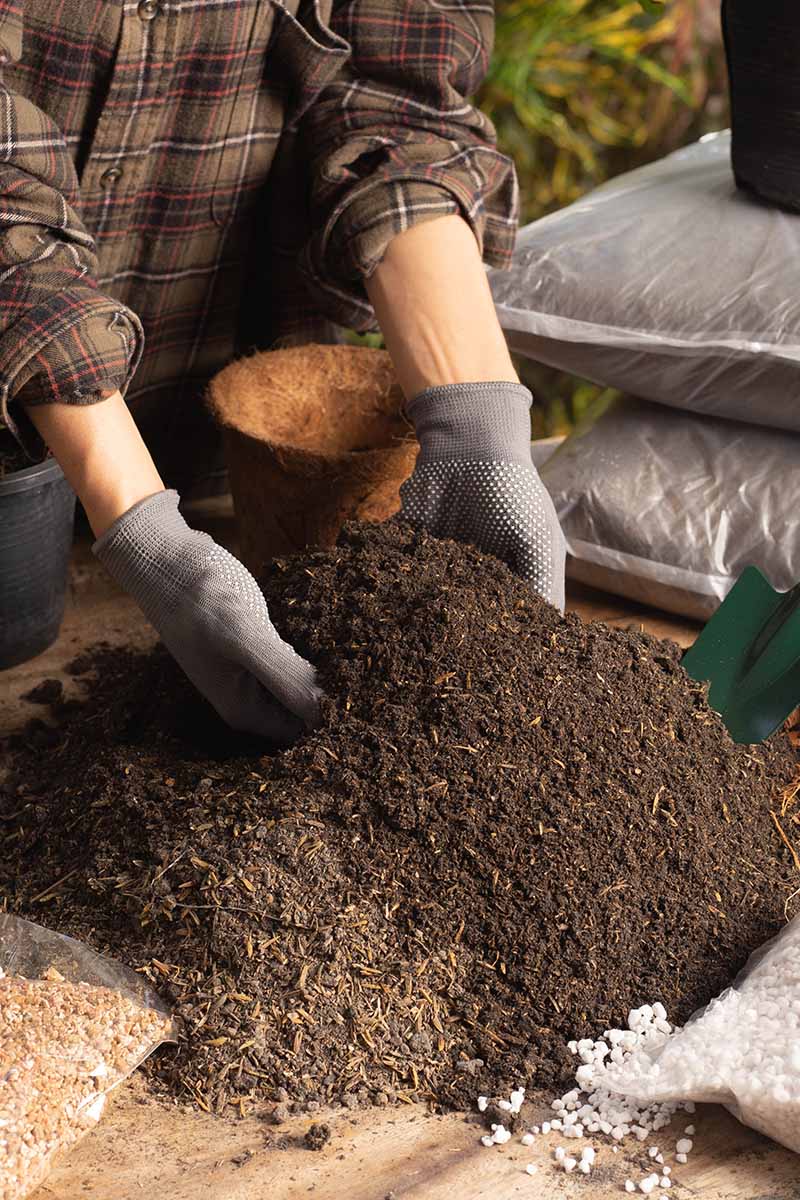
Avoid using native soil from your backyard which is typically too heavy for potted plants.
You can use a good quality commercial potting soil or mix your own planter blend.
Here’s a reliable three ingredient recipe for container plants that I like to use:
- Into a mixing bin or your growing container, add three parts of potting soil or three parts garden soil.
- Mix in one part of compost, well-rotted manure, or worm castings.
- Add one part pumice to condition the soil. Its highly porous nature is excellent at retaining nutrients and water and it helps maintain a light, airy texture that drains well and doesn’t become compacted.
If you can’t find pumice, perlite or vermiculite make good substitutes.
Place your containers on a catchment saucer then add your soil blend until the pot is three-quarters of the way full.
Set the roots in place so that the top of the root ball sits about two inches below the container’s rim.
Backfill with soil, gently tamping as you add dirt and checking to ensure the plant is sitting level with the culms upright. Keep adding soil until it’s an inch or two above the top of the root ball.
Firm in place then water gently but thoroughly, or until water starts to emerge from the drainage holes.
Add a one- or two-inch layer of mulch to the soil surface to help retain soil moisture. Use materials such as shredded bark, sphagnum moss, or gravel.
Container Care
For strong growth, provide about one inch of water per week to potted plants.
Keep the soil lightly moist but allow the top one to two inches of soil to dry out between applications.
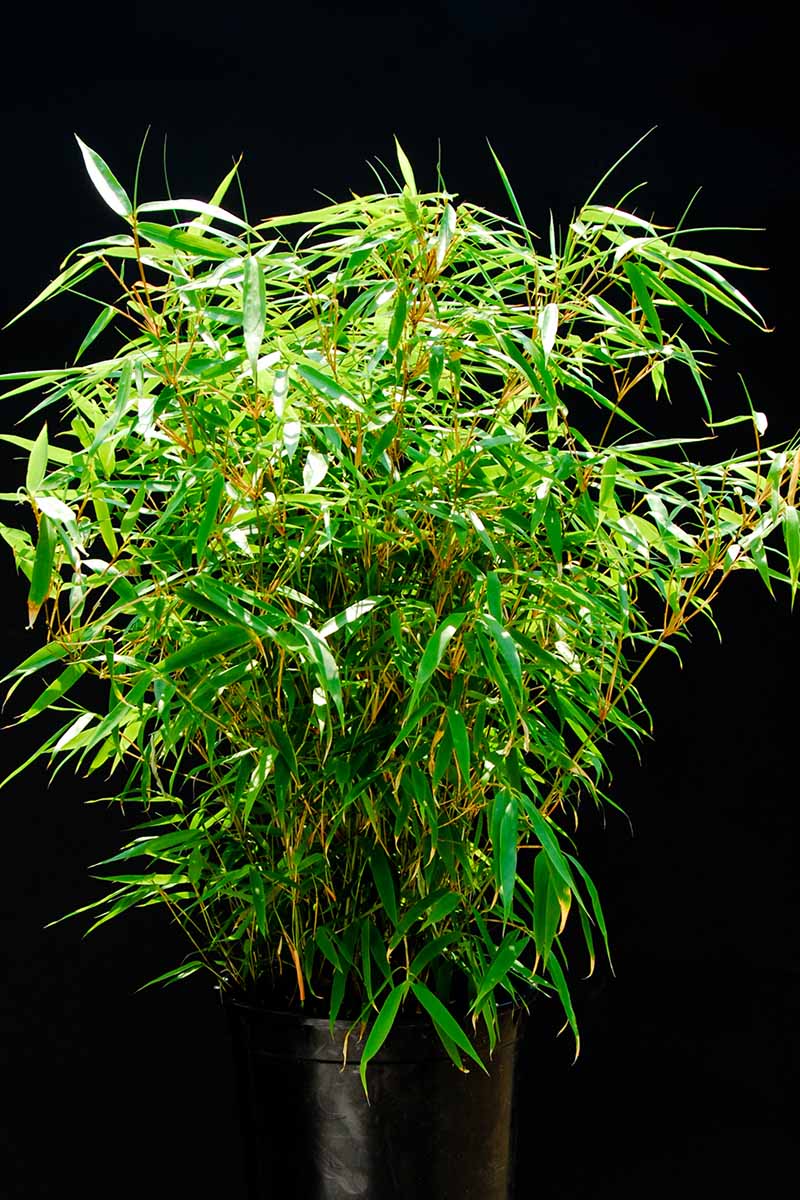
Also, in dry or hot temperatures, full sun, or windy conditions, spray the foliage with a light mist from the hose to maintain some ambient moisture.
Container-grown bamboo needs plenty of light to grow vigorously.
Provide plants with a full to partial sun location with at least six hours of sunlight per day in temperate regions.
In areas with harsh, intense sunlight and searing temperatures, provide light afternoon shade.
Although they’re not super heavy feeders, bamboo plants have a healthy appetite and respond best to fertilizing twice a year.
Use a granulated, slow-release fertilizer applied in early spring to meet the needs of new growth and again in midsummer to replenish depleted nutrients.
For the best results, use a product that has an NPK formula with slightly higher levels of nitrogen to produce an abundance of foliage.
Belonging to the Poaceae family of true grasses, a formula designed for lawns is a good choice for bamboo.
Or look for feeds with a ratio such as to 10-4-8 (NPK) – you want the first number, the nitrogen, to be higher than the other two.
Down to Earth’s Bio-Turf, available at Arbico Organics, has a ratio of 8-3-5 NPK that’s well suited to bamboo.
Maintenance and Pruning
Depending on the container size, potted plants can grow for three to five years before needing to be repotted into a larger container or dividing the roots for replanting in the same pot.

Division can be done in early spring or late autumn through winter but should be avoided during the active growing periods of spring and summer.
Here’s how to divide potted bamboo:
- To start the division process, first give your potted plants a good drink of water to hydrate the roots.
- Next, run a long knife, like a hori hori, between the root ball and the walls of the pot to help loosen the roots.
- Grab a handful of culms at the base and lift the plant from the pot. You might find it easier to first tip the pot on its side then slide the pot away from the roots.
- Use a pruning saw to remove a couple of inches of matted roots from the bottom of the rootball, and an inch or two from the sides.
- Return the plant to an upright position then use a pruning saw or sharp spade to cut the root ball into two or more sections.
- Trim each division, removing any dead or rotted roots and cleaning up culms at the same time, removing any that are broken, damaged, or dead.
- Remove chunks of loose soil from roots before repotting as outlined in the planting section above.
- After repotting, water each division thoroughly.
For winter maintenance, mulch the soil surface with two- to four-inches of organic materials such as bark mulch, shredded leaves, or straw.
The roots can also be protected from freezing temperatures by wrapping the pot in bubble wrap or burlap for extra insulation.
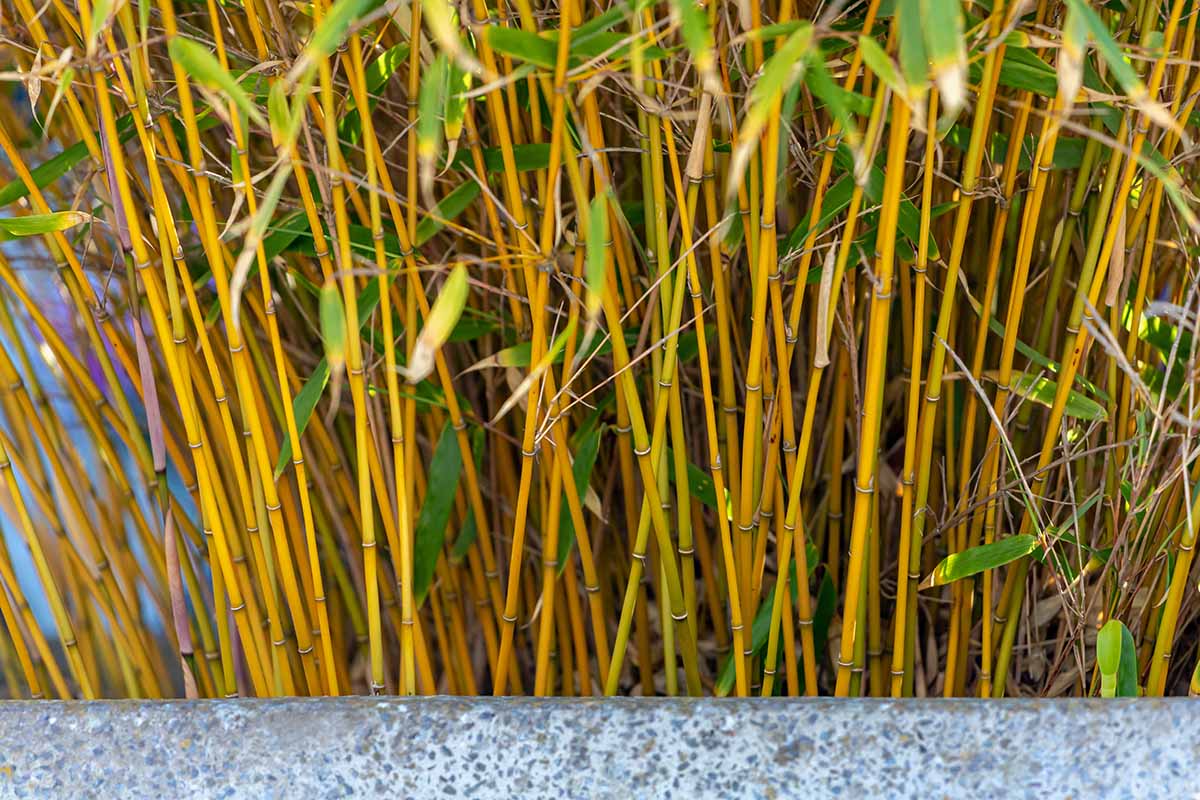
Remove catchment saucers in winter to ensure the soil drains freely.
If needed, move pots into a sheltered location to protect them from desiccating winds that can shred leaves – but they’ll still need plenty of bright light.
Plants can be thinned in winter by cutting the culms close to the soil surface.
To do this, first clean and trim out broken, damaged, or dead culms then select large, old culms to thin as desired.
To reduce the height of your bamboo, cut the culms just above a node.
Potted Airy Elegance
To enjoy the airy elegance of leafy bamboo, growing plants into large containers and planters is an ideal way to manage their spread and size!

Whether you choose the clumping or running types, ensure your containers have plenty of drainage holes to promote healthy roots.
Give them rich soil, fertilize twice during the growing season, and water regularly to maintain moist, but not wet, soil.
Then repot into a larger container or divide the root ball every few years for vibrant plants that are ideal as accent pieces on decks and patios or arranged in rows for barriers, hedges, or privacy screens.
Any thoughts about growing bamboo in pots and containers? Drop us a note in the comments section below.
And for more bamboo know-how, add these guides to your reading list next:

